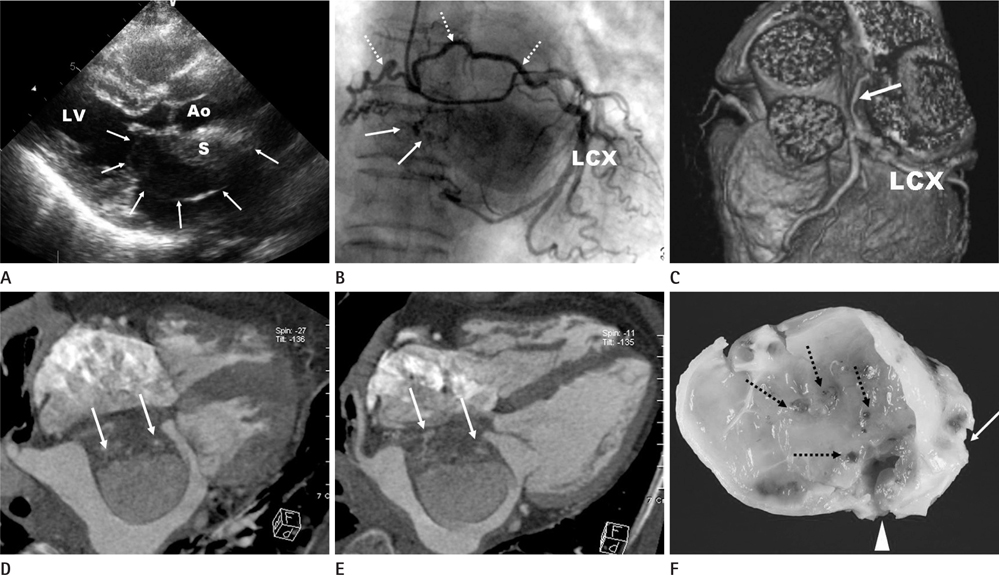J Korean Soc Radiol.
2011 Jul;65(1):35-39. 10.3348/jksr.2011.65.1.35.
Dynamic Multidetector CT Findings of Left Atrial Myxomas Causing Mitral Valve Obstruction
- Affiliations
-
- 1Department of Radiology, Soonchunhyang University College of Medicine, Bucheon, Korea.
- 2Department of Radiology, Chosun University School of Medicine, Gwangju, Korea. dhk1107@hanmail.net
- 3Department of Internal Medicine, Soonchunhyang University College of Medicine, Bucheon, Korea.
- 4Department of Cardiovascular Surgery, Soonchunhyang University College of Medicine, Bucheon, Korea.
- 5Department of Pathology, Soonchunhyang University, College of Medicine, Bucheon, Korea.
- KMID: 1443491
- DOI: http://doi.org/10.3348/jksr.2011.65.1.35
Abstract
- We report multidetector row CT (MDCT) findings of two left atrial myxomas causing mitral valve obstruction and dyspnea of patients. Cardiac MDCT showed well-defined left atrial masses attached to the interatrial septum and shifting of tumors into the left ventricle causing mitral valve obstruction during diastole in a 37-year-old male and in a 69-year-old female. Also, we observed intratumoral hemorrhage in the second case. Myxomas were resected and the patients were discharged without dyspnea.
MeSH Terms
Figure
Reference
-
1. Burke AP, Virmani R. Cardiac myxoma. A clinicopathologic study. Am J Clin Pathol. 1993; 100:671–680.2. Scheffel H, Baumueller S, Stolzmann P, Leschka S, Plass A, Alkadhi H, et al. Atrial myxomas and thrombi: comparison of imaging features on CT. AJR Am J Roentgenol. 2009; 192:639–645.3. Kim EY, Choe YH, Sung K, Park SW, Kim JH, Ko YH. Multidetector CT and MR imaging of cardiac tumors. Korean J Radiol. 2009; 10:164–175.4. Awamleh P, Alberca MT, Gamallo C, Enrech S, Sarraj A. Left atrium myxosarcoma: an exceptional cardiac malignant primary tumor. Clin Cardiol. 2007; 30:306–308.5. Pinede L, Duhaut P, Loire R. Clinical presentation of left atrial cardiac myxoma. A series of 112 consecutive cases. Medicine (Baltimore). 2001; 80:159–172.6. Gerber BL, Bluemke DA, Rumberger JA, Horton KM, Lima JAC. Cardiac imaging of masses, tumors, and thrombi. In : Sutton MG, Rutherford JD, editors. Clinical cardiovascular imaging: a companion to Braunwald's heart disease. Philadelphia: Elsevier Saunders;2004. p. 414–437.7. Chow WH, Chow TC, Tai YT, Yip AS, Cheung KL. Angiographic visualization of 'tumour vascularity' in atrial myxoma. Eur Heart J. 1991; 12:79–82.8. Grebenc ML, Rosado de Christenson ML, Burke AP, Green CE, Galvin JR. Primary cardiac and pericardial neoplasms: radiologic-pathologic correlation. Radiographics. 2000; 20:1073–1103. quiz 1110-1111, 1112.9. Tsuchiya F, Kohno A, Saitoh R, Shigeta A. CT findings of atrial myxoma. Radiology. 1984; 151:139–143.10. Bjessmo S, Ivert T. Cardiac myxoma: 40 years' experience in 63 patients. Ann Thorac Surg. 1997; 63:697–700.
- Full Text Links
- Actions
-
Cited
- CITED
-
- Close
- Share
- Similar articles
-
- Pregnancy, Paroxysmal Nocturnal Dyspnea, Presyncope, and Plop: A Case of Left Atrial Myxoma Causing Mitral Valve Obstruction in Pregnancy
- Relation between Atrial Fibrillation and Echocardiographic Size of Left Atrium
- Free-Floating Left Atrial Thrombus with Recurrent cerebral Embolic Event Associated Mitral Stenosis
- Left Atrial Wall Calcification after Mitral Valve Replacement: CT Findings and Clinical Significance
- Left Atrial Wall Dissection after Mitral Valve Replacement



